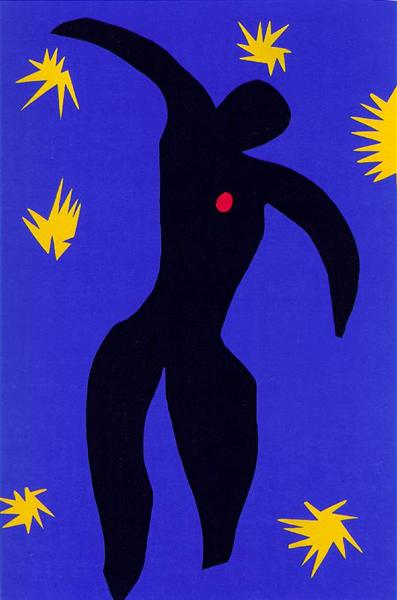Description
"Icarus," created by Henri Matisse in 1944, is a masterpiece that exemplifies the artist's innovative approach in his final stage, when he dedicated himself to the technique of cutting painted paper known as "gouaches découpés." This painting is part of his "Jazz" series, a set of vibrant works that reflect both the vitality and bold simplicity that defined his late works. The central figure in "Icarus" is a stylized black silhouette, floating in a deep blue environment, surrounded by golden stars that seem to throb with emotional and luminous intensity.
The composition of "Icarus" is notable for its apparent simplicity and expressiveness. The black figure, representing Icarus, is created from a simple yet effective outline, with arms and legs extended in a gesture that evokes both elevation and fall. The character's chest is marked by a vibrant red heart that suggests an intensity of feelings, perhaps the passion and daring that led Icarus to fly too close to the sun. This focused use of color in the heart provides a point of interest that markedly contrasts with the austerity of the rest of the figure.
The blue background that envelops Icarus is deep and dark, almost nocturnal, suggesting a vast sky or, more symbolically, the void of space. The golden stars scattered around Icarus not only act as decorative elements but also enhance a dramatic effect; these stars, with their irregular and radiant shapes, give the scene an ethereal quality and hint at the danger and beauty of the height Icarus desired to reach.
It is important to consider the context in which Matisse created this work. After an operation due to cancer, Matisse was physically limited and adopted paper cutting as his main medium of artistic expression. This technique allowed him to continue creating despite his limitations, and he often described this process as "drawing with scissors." In "Icarus," this technique brings a dynamic and tactile quality that emphasizes the energy and movement of the figure, despite the apparent stillness of the cutouts.
"Icarus" is not only a modern representation of the Greek myth; it is a bold statement about the human condition: the yearning to transcend limits, the quest for freedom, and the inherent dangers of such daring. Matisse, through formal simplicity, manages to capture the essence of the myth with an emotional depth that communicates directly with the viewer, eliminating any time-cultural barrier that might exist.
The choice of subject is also a reflection on the world situation in 1944, a period marked by World War II. In this context, the figure of Icarus can symbolize both the audacity and the tragedy of humanity in its quest for freedom and knowledge. Matisse, perhaps unconsciously, encapsulated these collective feelings in his work, achieving a perfect union between form, color, and meaning.
In conclusion, Henri Matisse's "Icarus" is a work that, through its measured simplicity and masterful use of color and cutting technique, offers a powerful and contemporary representation of the classic myth. It is both a testament to the artist's resilience and a moving reflection of universal human longings.

